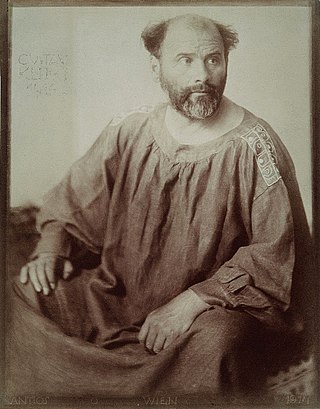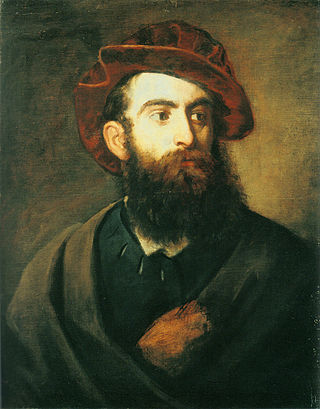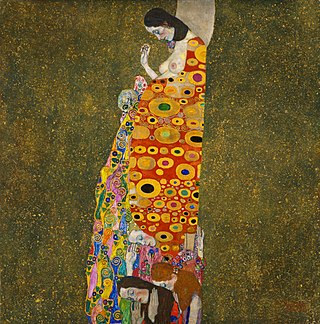
Gustav Klimt was an Austrian symbolist painter and one of the most prominent members of the Vienna Secession movement. Klimt is noted for his paintings, murals, sketches, and other objets d'art. Klimt's primary subject was the female body, and his works are marked by a frank eroticism. Amongst his figurative works, which include allegories and portraits, he painted landscapes. Among the artists of the Vienna Secession, Klimt was the most influenced by Japanese art and its methods.

Oskar Kokoschka was an Austrian artist, poet, playwright, and teacher best known for his intense expressionistic portraits and landscapes, as well as his theories on vision that influenced the Viennese Expressionist movement.

Hans Makart was a 19th-century Austrian academic history painter, designer, and decorator. Makart was a prolific painter whose ideas significantly influenced the development of visual art in Austria-Hungary, Germany, and beyond.

The Vienna Secession is an art movement, closely related to Art Nouveau, that was formed in 1897 by a group of Austrian painters, graphic artists, sculptors and architects, including Josef Hoffman, Koloman Moser, Otto Wagner and Gustav Klimt. They resigned from the Association of Austrian Artists in protest against its support for more traditional artistic styles. Their most influential architectural work was the Secession exhibitions hall designed by Joseph Maria Olbrich as a venue for expositions of the group. Their official magazine was called Ver Sacrum, which published highly stylised and influential works of graphic art. In 1905 the group itself split, when some of the most prominent members, including Klimt, Wagner, and Hoffmann, resigned in a dispute over priorities, but it continued to function, and still functions today, from its headquarters in the Secession Building. In its current form, the Secession exhibition gallery is independently led and managed by artists.

The Leopold Museum, housed in the Museumsquartier in Vienna, Austria, is home to one of the largest collections of modern Austrian art, featuring artists such as Egon Schiele, Gustav Klimt, Oskar Kokoschka, and Richard Gerstl.

The Kiss is an oil-on-canvas painting with added gold leaf, silver and platinum by the Austrian Symbolist painter Gustav Klimt. It was painted at some point in 1907 and 1908, during the height of what scholars call his "Golden Period". It was exhibited in 1908 under the title Liebespaar as stated in the catalogue of the exhibition. The painting depicts a couple embracing each other, their bodies entwined in elaborate beautiful robes decorated in a style influenced by the contemporary Art Nouveau style and the organic forms of the earlier Arts and Crafts movement.

Portrait of Adele Bloch-Bauer I is an oil painting on canvas, with gold leaf, by Gustav Klimt, completed between 1903 and 1907. The portrait was commissioned by the sitter's husband, Ferdinand Bloch-Bauer, a Viennese and Jewish banker and sugar producer. The painting was stolen by the Nazis in 1941 and displayed at the Österreichische Galerie Belvedere. The portrait is the final and most fully representative work of Klimt's golden phase. It was the first of two depictions of Adele by Klimt—the second was completed in 1912; these were two of several works by the artist that the family owned.

The Klimt University of Vienna Ceiling Paintings, also known as the Faculty Paintings, were a series of paintings made by Gustav Klimt for the ceiling of the University of Vienna's Great Hall between the years of 1900–1907. In 1894, Klimt was commissioned to paint the ceiling. Upon presenting his paintings, Philosophy, Medicine and Jurisprudence, Klimt came under attack for 'pornography' and 'perverted excess' in the paintings. None of the paintings would go on display in the university.

The Beethoven Frieze is a painting by Gustav Klimt on display in the Secession Building, Vienna, Austria.

Serena (Szeréna) Pulitzer Lederer was an Austro-Hungarian art collector and the spouse of the industrial magnate August Lederer, close friend of Gustav Klimt and instrumental in the constitution of the collection of Klimt's art pieces.

The Three Ages of Woman is a painting that was completed in Austria in 1905 by Gustav Klimt, symbolist painter and one of the most prominent members of the Vienna Secession movement.

Hope II is an oil-on-canvas painting with added gold and platinum by the Austrian symbolist artist Gustav Klimt, made in 1907–08, depicting a pregnant woman with closed eyes. It was the second of Klimt's works to focus on a pregnant woman, both depicting Herma, one of his favourite models. It was entitled Vision by Klimt, but has become known as Hope II after the earlier work Hope, which is now distinguished as Hope I. Hope II was acquired by the Museum of Modern Art in New York City in 1978.

Schloss Immendorf was a castle in the village of Immendorf near the market town of Wullersdorf in the district of Hollabrunn in the northeast of Lower Austria, within the Weinviertel region.

August Lederer, was an Austrian industrialist and art collector whose art collection was looted by Nazis. He helped promote the artists of the Vienna Secession, notably Gustav Klimt.

Lady with a Fan was the final portrait created by Gustav Klimt. Painted in 1917, the uncommissioned piece depicting an unidentified woman was on an easel in his studio when he died in 1918. Like many of Klimt's late works, it incorporates strong Asian influences including many Chinese motifs.

Portrait of Johanna Staude (1917–1918) is an unfinished painting by Gustav Klimt, depicting Johanna Staude, an Austrian divorcée who also modeled for Egon Schiele. She described her occupation as language teacher, and later, as a painter, although no works of her own are known. The Financial Times has described the Klimt painting as the culmination of his development as a portraitist, portraying "a new, post-war woman, self-aware, intelligent, modern, staring boldly out at us, sporting a fashionable short hair-cut and black feather boa". The painting was acquired by the Österreichische Galerie Belvedere in 1963.

Portrait of Fräulein Lieser is a portrait created by Gustav Klimt. Painted in 1917, the piece was left unsigned in his studio when he died in 1918. It was presumed lost or broken by experts until it was discovered in adequate condition in 2024.

Women Friends (1916-1917) is a painting by Austrian symbolist painter Gustav Klimt. Alternatively known as The Friends, or Girlfriends II, among others, the work was destroyed by fire in 1945 alongside several other of Klimt's paintings in the burning of Schloss Immendorf.

Jenny Steiner was an Austro-Hungarian art collector, patron of the arts and factory owner expropriated under the Nazis.



















